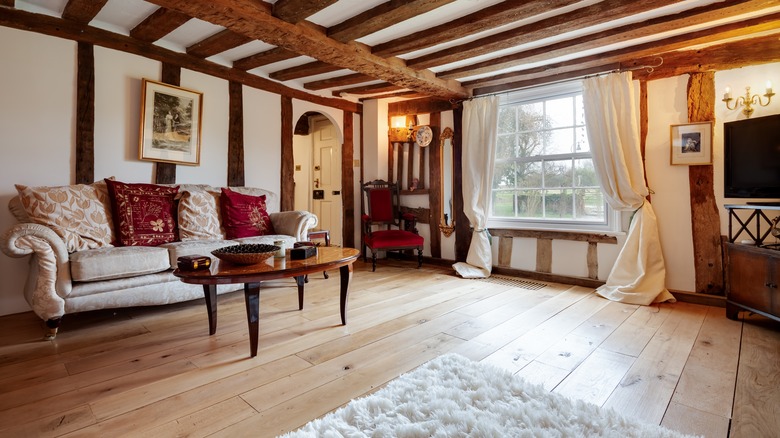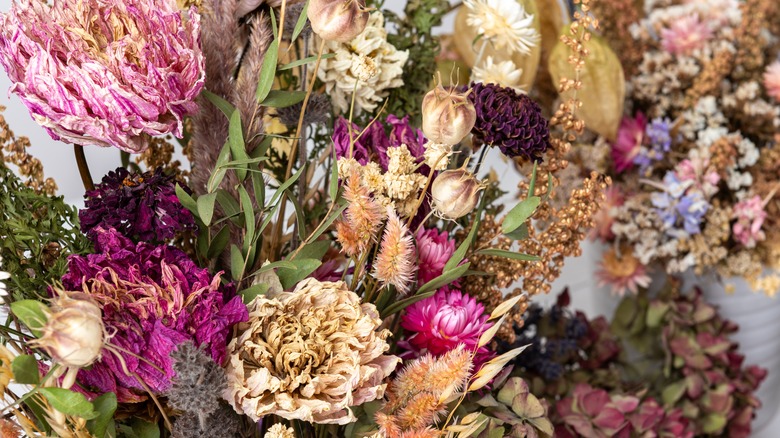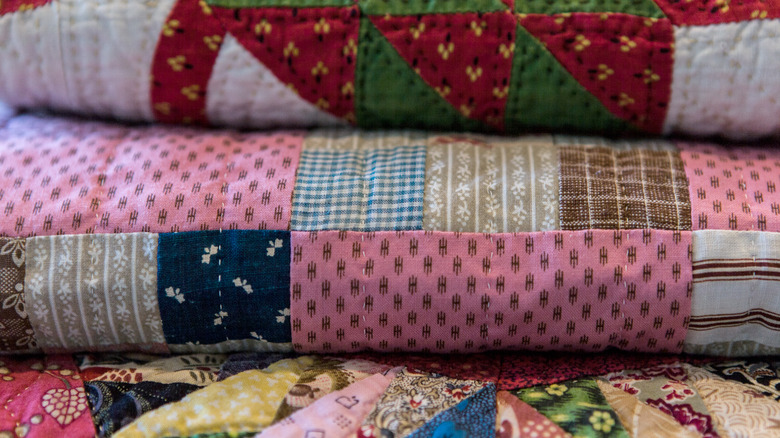The One Thing Missing From Your Cottagecore Living Room Color Palette
French country design is one of the most popular interior decorating styles of all time. It asks you to imagine living in the country where life is allegedly more relaxed. You are surrounded by overgrown gardens and used but adored vintage furnishings and textiles. It embraces a rose-colored vision of the past and eschews hard-edged design and visible signs of technology. A version of its aesthetic is always flowing in and out of favor. Survivors of the '80s remember French blue walls and inexplicable motifs of geese festooned with ribbons. The '90s brought Rachel Ashwell's frilly, girly Shabby Chic. Today, it's cottagecore.
Cottagecore attracts fans with its combination of timeless country charm, modern notions of sustainability, and minimalist simplicity. It can be difficult to embrace its tenants with a home office or kitchen that's free of high-tech appliances. But a cozy, restful living room is the ideal setting for cottagecore decor. A cottagecore living room's design must begin with the one thing it can't be without: a soothing, neutral hue. You can select muted hues with little or no contrasting colors or embrace gentle contrasts and subtle patterns. Let your preferences guide you as you customize the color palette and accessories of your cottagecore living room.
Choosing your cottagecore color palette
To choose cottagecore colors, imagine a bouquet of flowers left to dry and fade in the sunshine. Their colors will not be vibrant hues like fuchsia or emerald. They'll be tints (pure colors with white added) or tones (pure colors with gray added). Pastels like pink, peach, and baby blue are tints. Tones include muted colors like sage green, slate blue, or taupe. If you love purple, your colors could be a tint like lavender and a tone like French violet.
You can simplify the process and find your perfect palette using a color wheel ($3.69 at Blick). Typically, the front side of the spinnable wheel shows you how to mix colors, and the back shows their tints, tones, shades, and the colors they harmonize with. It takes a brief study to understand how it works, but once you know it, you'll always get colors right — it's magic. Select your color, and the wheel shows you which pure hues, tones, tints, and shades go with it in palettes of two, three, and four colors. The subtlest cottagecore palettes will have closely related or tone-on-tone colors, aka shades of the same color — for instance, off-white and chiffon yellow, shell pink and blush, dove gray and ecru, or tone-on-tone colors like pink, light pink, and pale pink. If you would prefer that your cottagecore home feels more like a fairytale cottage, choose contrasting colors like violet, chiffon yellow, and pale green.
Accessory secrets to elevate your cottagecore color palette
Bring your color palette to life with patterns, wood, accessories, and lighting. With cottagecore's emphasis on sustainability, used and repurposed items are part of its charm. Have you stored vintage ribbons, doilies, lace tablecloths, quilts, or crocheted blankets? Could you transform any old floral, gingham, or tartan sheets into throw pillows? Can you incorporate your stash of aged and imperfect silver plates and China? Retro furniture with dings, imperfections, or cracked finishes works too. Wood finishes are at home with cottagecore but should match your color choices. Red cherry or orange-red mahogany might be jarring with linen or yellow colors but lovely with blues and greens; pale birch or honey-colored maple pairs well with beige, pink, and peach. Cool woods like walnut and ash are elegant with greens, violets, and periwinkles.
Lighting is the ultimate secret to a rich display of color. The ideal lighting choices for cottagecore are natural daylight, candlelight, or warm lighting. Understand that warm and cold light are not related to temperature but to the spectrum of light they produce. Cool lighting is ideal for tasks and staying alert, but we need warm light for a relaxing mood and a vintage vibe. Use sheer or lace curtains to allow the maximum natural light by day. For the evening, select fixtures with warm light bulbs. Vintage-styled stained-glass fixtures will also be at home in your cottagecore living room. These just-so touches will enhance your cozy space's appearance and color palette.


